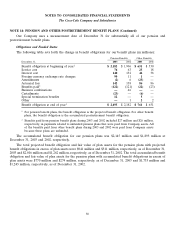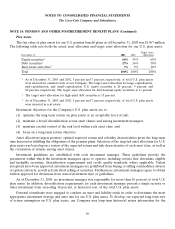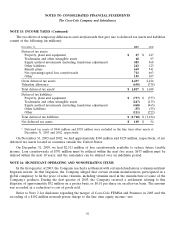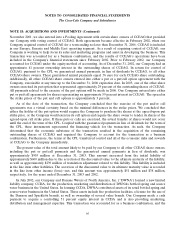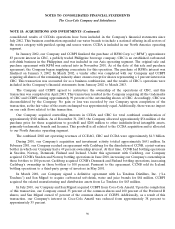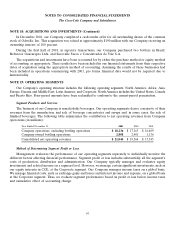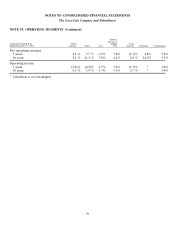Coca Cola 2003 Annual Report Download - page 92
Download and view the complete annual report
Please find page 92 of the 2003 Coca Cola annual report below. You can navigate through the pages in the report by either clicking on the pages listed below, or by using the keyword search tool below to find specific information within the annual report.
NOTES TO CONSOLIDATED FINANCIAL STATEMENTS
The Coca-Cola Company and Subsidiaries
NOTE 14: PENSION AND OTHER POSTRETIREMENT BENEFIT PLANS (Continued)
Plan Assets
The fair value of plan assets for our U.S. pension benefit plans as of December 31, 2003 was $1,467 million.
The following table sets forth the actual asset allocation and target asset allocation for our U.S. plan assets:
Target Asset
December 31, 2003 2002 Allocation
Equity securities166% 55% 60%
Debt securities227% 36% 30%
Real estate and other37% 9% 10%
Total 100% 100% 100%
1As of December 31, 2003 and 2002, 5 percent and 7 percent, respectively, of total U.S. plan assets
were invested in common stock of our Company. The target asset allocation for large–capitalization,
mid–capitalization, and small–capitalization U.S. equity securities is 20 percent, 9 percent and
20 percent, respectively. The target asset allocation for international equity securities is 11 percent.
2The target asset allocation for high–yield debt securities is 15 percent.
3As of December 31, 2003 and 2002, 5 percent and 7 percent, respectively, of total U.S. plan assets
were invested in real estate.
Investment objectives for the Company’s U.S. plan assets are to:
(1) optimize the long-term return on plan assets at an acceptable level of risk;
(2) maintain a broad diversification across asset classes and among investment managers;
(3) maintain careful control of the risk level within each asset class; and
(4) focus on a long-term return objective.
Asset allocation targets promote optimal expected return and volatility characteristics given the long-term
time horizon for fulfilling the obligations of the pension plans. Selection of the targeted asset allocation for U.S.
plan assets was based upon a review of the expected return and risk characteristics of each asset class, as well as
the correlation of returns among asset classes.
Investment guidelines are established with each investment manager. These guidelines provide the
parameters within which the investment managers agree to operate, including criteria that determine eligible
and ineligible securities, diversification requirements and credit quality standards, where applicable. Unless
exceptions have been approved, investment managers are prohibited from buying or selling commodities, futures
or option contracts, as well as from short selling of securities. Furthermore, investment managers agree to obtain
written approval for deviations from stated investment style or guidelines.
As of December 31, 2003, no investment manager was responsible for more than 10 percent of total U.S.
plan assets. In addition, diversification requirements for each investment manager prevent a single security or
other investment from exceeding 10 percent, at historical cost, of the total U.S. plan assets.
External consultants were engaged to conduct an asset and liability study in order to determine the most
appropriate investment strategy and asset mix for our U.S. plan assets. To develop our expected long-term rate
of return assumption on U.S. plan assets, our Company uses long-term historical return information for the
89









